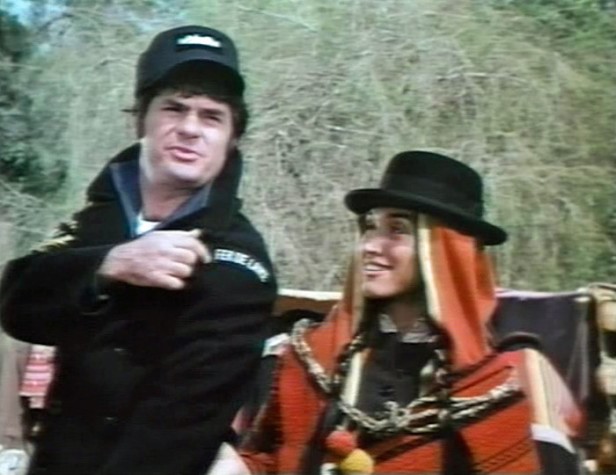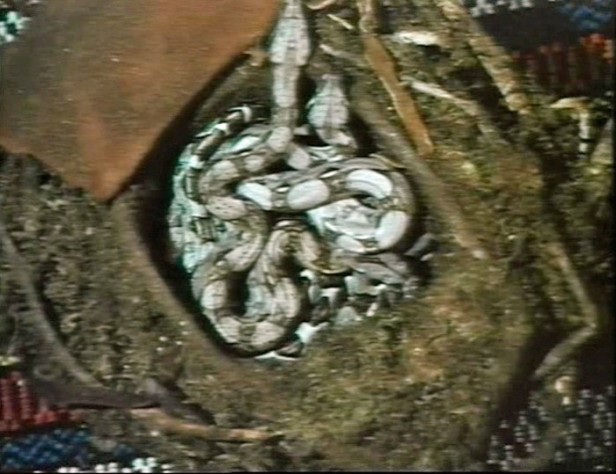A Fer-de-Lance, French for spear of lance head, is the name given to several highly venomous species of snake of the genus Bothrops. And quite terrifying creatures they are too. It’s also, in Russ Mayberry’s television film, first broadcast on CBS on 18 October 1974, the name of an American navy submarine which – and who soon this coming? – is overrun by the very snakes it’s named after. It proves to be rather less terrifying. Many years before Samuel L. Jackson had to deal with those mother&*$^ing snakes on a mother&*$^ing plane, it was David Janssen trying to cope with it all and while he does a stoic ebough job, the script is so tedious we really don’t care one jot about him or anyone else on board.
In a Tierra del Fuego where everyone dresses like they’re in the high Andres, the submarine Fer-de-Lance docks and its crew are allowed shore leave. Seaman Compton (Frank Bonner), not exactly the US Navy’s brightest or finest, buys some baby snakes from a market stall and smuggles them back aboard ship. We all know what’s going to happen (Dominic Frontiere’s ominous music cues see to that) but it’s going to be quite some while before we get to what passes as the good stuff, instead having to make do with the dull everyday routine of the submariners as they pick up a team of deep-sea divers and head off to the Sealab project to investigate underwater detonations. This takes up a good chunk of the film and is very dreary stuff. When the snakes finally escape from the conduit containing the sub’s hot water pipes where Compton has stashed them, they’re soon slithering about creating mayhem, killing crew members and causing the submarine to crash into the seabed, becoming trapped under an underwater cliff face leaving Lieutenant Whitehead (Ben Piazza) and Chief of the Boat Russ Hogan (Janssen) to hold the surviving crew again and get them to safety.

Fer-de-Lance isn’t much of a horror film though in fairness, one suspects that screenwriter Leslie Stevens never really meant it to be. The snakes pose less of a threat than they should have – they’re largely written out for great stretches – and a lot of the time is spent on the virtually suspense-free attempts to get the sub off the ocean floor. The snakes seem almost incidental to the plot, lurking around the periphery to fill in a few gaps when the general tediousness of the storyline becomes all but unendurable. A problem with many an underwater-set film is that beyond the horror of claustrophobia (something that Mayberry seems to have opted not to have explored here to any extent) there’s not really much of any interest going on. Men sweat manfully, panic sets in and then… no-one has anywhere to go so they just sit around getting tetchy with each other. And very dull it all is too.
The film was the work of many of the personnel that had made The Outer Limits (1963-1965) (Stevens was the show’s creator and executive producer, Frontiere its composer, Fer-de-Lance‘s producer Elaine Michea had been The Outer Limits‘ production coordinator) but it couldn’t be further from that series if it tried. Where the series had mostly been comprised of compact, smartly written and clever short stories, Fer-de-Lance is flabby and padded to the hilt. It plods leadenly along its way, never sparking any interest and wending its way to a very unsatisfying conclusion. The cast (which also includes Hope Lange, Ivan Dixon and Jason Evers) earn it a few extra points but Stevens’ ponderous script and Mayberry’s lacklustre direction do them no favours at all.

Strangely this entirely unprepossessing film got a cinema release in the UK under the title Death Dive (it can also be found under the title Operation Serpent) in mid-1976, initially on a double bill with the Australian comedy Side by Side (1975) starring Barry Humphries. Distributors GTO were desperately trying to ride the wave of disaster films set in motion by Earthquake (1974), The Towering Inferno (1974) and perhaps most appropriately The Poseidon Adventure (1972). But while those films were able to command starry casts and boasted action on a huge scale, Fer-de-Lance was never going to be able to live up to them and must have seemed like very weak beer indeed. It wasn’t all that much on the small screen, one can only imagine how cheap (the sub crash consists of some nice camerawork spoiled by shot-in-a-fish-tank effects) and cheerless it must have looked blown up to the big screen.